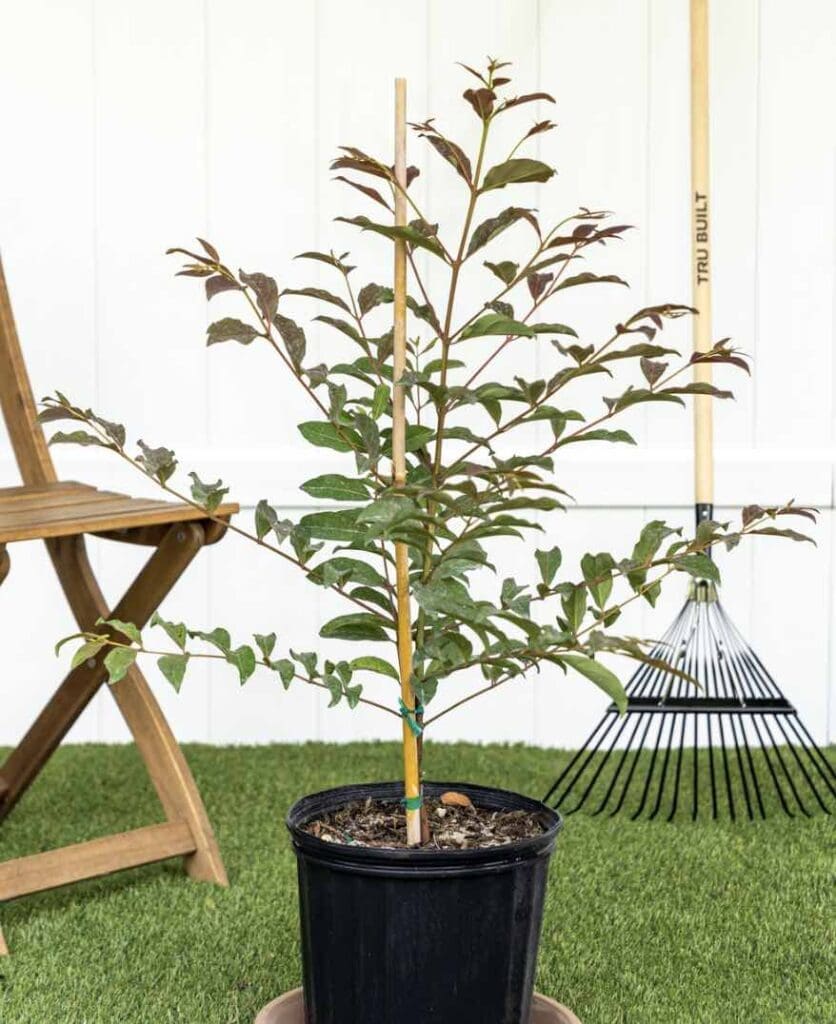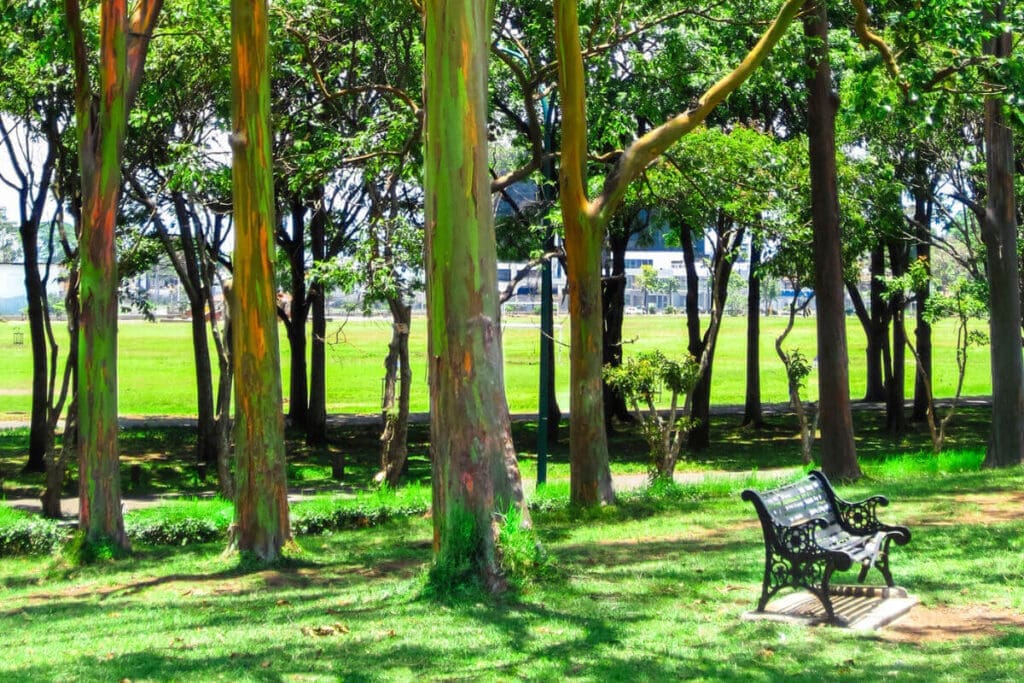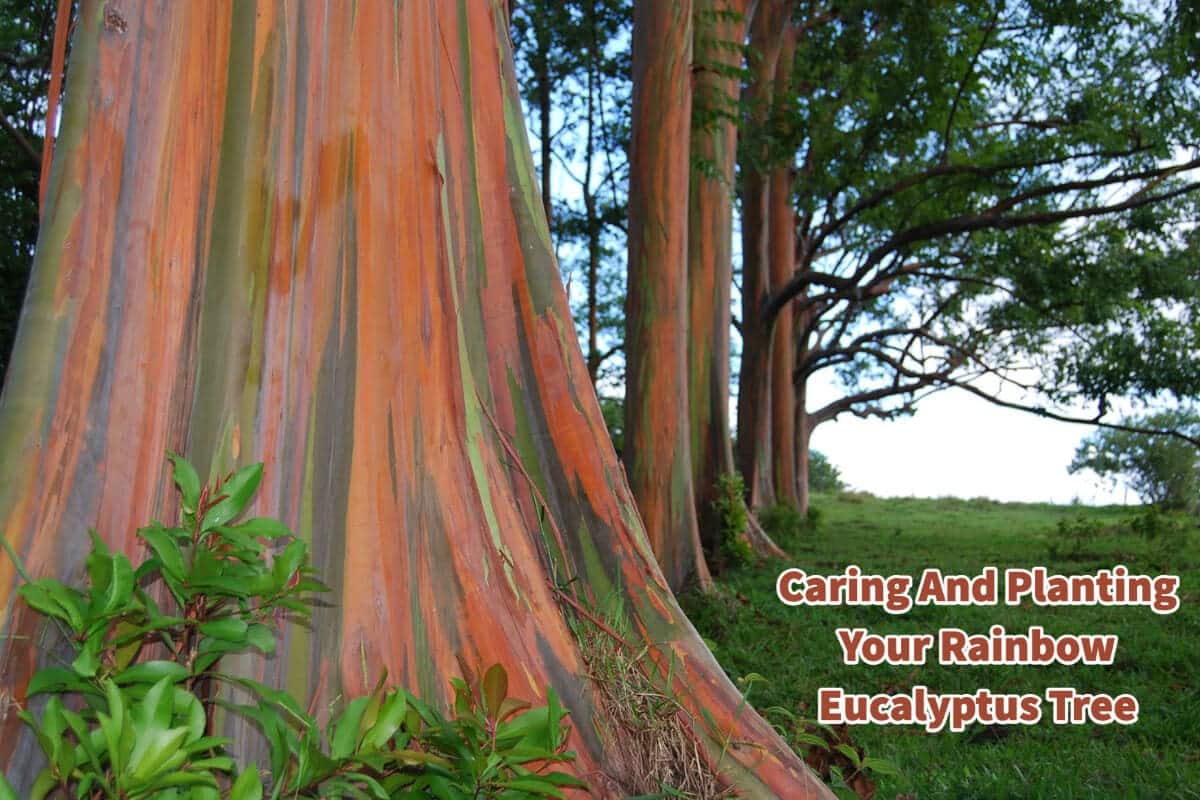While the Rainbow Eucalyptus tree is often admired in commercial spaces like parks or botanical gardens, this doesn’t mean you can’t have one gracing your backyard or home.
If your environment meets the right conditions, it is feasible to nurture this magnificent tree yourself. However, to successfully plant and diligently care for this arboreal wonder, you need to be aware of and consider some essential factors and guidelines. Read on as we explore how you can plant and care for your own Rainbow Eucalyptus Tree.
Table of Contents
- Caring And Planting Your Rainbow Eucalyptus Tree: A Comprehensive Guide
- Planting Your Rainbow Eucalyptus Tree: When, Where, And How?
- Potting Rainbow Eucalyptus
- Care For Your Rainbow Eucalyptus Tree
- Root System Of The Rainbow Eucalyptus Tree
- Embracing The Journey Of Growing Your Rainbow Eucalyptus Tree
- Related Content
Caring And Planting Your Rainbow Eucalyptus Tree: A Comprehensive Guide
The Rainbow Eucalyptus tree, also known as Eucalyptus deglupta, is a stunning testament to nature’s vibrancy and diversity. If you’re considering adding this breathtaking tree to your yard or home, this guide will help you understand its planting requirements and how to care for it properly.

The Rainbow Eucalyptus Trees Explored
Rainbow Eucalyptus, native to Australia, stands out from other eucalyptus species due to its unique and vibrant bark. When its bark peels, it reveals a technicolor display of bright blues, purples, oranges, and reds.
Before we dive into its care and planting, let’s explore the general characteristics of eucalyptus trees.
Eucalyptus trees, originating from Australia, are widespread and include species like the silver dollar tree and the gum tree.
Each has unique characteristics but tolerates various soil and moisture conditions. Two species, E. credulata, and E. neglecta, even thrive under partial shade.
Planting Your Rainbow Eucalyptus Tree: When, Where, And How?

We will explore the best time to plant your Rainbow Eucalyptus Tree by answering when, where, and how to plant the tree properly.
When To Plant
The best time to plant your Rainbow Eucalyptus tree depends on location and climate. Ideally, it should be planted in mid to late spring or fall, giving it ample time to establish its roots before the harsh weather of summer or winter.
Where To Plant
Rainbow Eucalyptus trees prefer total sun exposure but can tolerate partial shade. They also need well-draining soil, even if it’s wet. Ensure you choose a location that satisfies these conditions to give your tree the best chance to thrive.
How To Plant
When preparing, the planting hole should be slightly larger than the tree’s root ball. Handle the roots carefully, as they are sensitive and crucial to the tree’s survival. Fill the hole with the same soil you removed and lightly tamp it down to avoid air pockets.
Potting Rainbow Eucalyptus
Certain eucalyptus species, including the Rainbow Eucalyptus, can thrive in pots. Ensure the pot has a diameter of at least 2 feet and features good drainage. Indoor growing is advisable if your climate frequently drops below 10 degrees Celsius (50 degrees Fahrenheit), as eucalyptus trees cannot tolerate such cold temperatures for prolonged periods.
In summer, you can move your potted Rainbow Eucalyptus outside to enjoy the sun.
Care For Your Rainbow Eucalyptus Tree
Rainbow Eucalyptus trees are relatively low-maintenance once they’re well-established. But there are still things you need to consider to care for your tree.
Watering
While they don’t need frequent watering, potted Rainbow Eucalyptus trees require draining between waterings to prevent waterlogging. During severe droughts, you might need to water them more often.
Fertilizing
Eucalyptus trees don’t need regular fertilizing and can even suffer from excessive phosphorous. However, potted eucalyptus may benefit from occasional slow-release fertilizer.
Pruning
Annual pruning, ideally in summer, is crucial for controlling your Rainbow Eucalyptus tree’s growth. This helps maintain a manageable size indoors or within a confined space.
Root System Of The Rainbow Eucalyptus Tree
The Rainbow Eucalyptus, known scientifically as Eucalyptus deglupta, is renowned for its imposing size and vibrant, multicolored bark. What’s less visible but equally impressive is its root system.
The root system of a rainbow eucalyptus is extensive, reflecting the tree’s overall size and stature.
When planted outdoors, this tree’s root system can spread up to 125 feet.
Yes, you read that right! This substantial root spread provides the stability and nourishment the tree needs to reach its notable heights and support its broad, leaf-laden branches.
It’s an invisible life network beneath the surface, silently working to keep the tree healthy and robust.
Careful Planting Is Necessary For The Rainbow Eucalyptus Tree
Given this vast root spread, careful planning is necessary when deciding where to plant your rainbow eucalyptus tree. Planting trees at a considerable distance from buildings is recommended to prevent potential damage to nearby structures.
Some experts suggest that the tree should be planted at least 60 feet away from a building to allow its roots ample space to spread without posing a risk to its foundation.
However, other sources recommend a minimum of 40 feet away. The exact distance may vary depending on the specific soil and environmental conditions, as well as the expected growth rate of the tree.
When planting a rainbow eucalyptus tree, it must account for its above-ground and below-ground growth. While the vibrant, peeling bark of the rainbow eucalyptus is a sight to behold, its sprawling roots are an equally significant part of the tree’s life and growth.
Therefore, the tree’s underground presence should be given equal importance to its above-ground growth when considering the planting location.
The root system of the rainbow eucalyptus is expansive, reinforcing the grandeur of this unique species. Therefore, while planning to plant one in your yard or garden, consider its underground footprint, ensuring it has the space to grow and flourish without causing structural issues.
A well-spaced and carefully planted rainbow eucalyptus tree can provide you with years of visual delight and a magnificent showcase of nature’s artistry.
Embracing The Journey Of Growing Your Rainbow Eucalyptus Tree
While it’s important to note that these care tips are general guidelines, the exact needs of your Rainbow Eucalyptus tree might vary based on its specific environment and conditions. By observing and adjusting your care routine accordingly, you can ensure your tree thrives.

The reward for your efforts is a spectacular tree that brightens your surroundings with its colorful display and refreshing scent. It’s a worthy investment of time and effort, offering you an unparalleled connection with nature and contributing to global biodiversity. So, go ahead and take that leap.
Plant your Rainbow Eucalyptus tree and embark on this journey of growth and discovery. Remember, the journey is as important as the destination in gardening and life. Having a Rainbow Eucalyptus tree is a journey worth having.
If you want to see how Mondoro can help you with your home decor and furniture needs, we would love to talk to you about how we can help you.
Find out more about how Mondoro can help you create, develop, and manufacture excellent home decor and furniture products – don’t hesitate to contact me, Anita. Check out my email by clicking here or become a part of our community and join our newsletter by clicking here.
Mondoro gives out a FREE Lookbook to anyone interested. You can receive a copy of our latest Lookbook by clicking here.
Listen to our Podcast called Global Trade Gal. You can find it on all major podcast platforms. Try out listening to one of our podcasts by clicking here.
Subscribe to our Mondoro Company Limited YouTube Channel with great videos and information by clicking here.
Related Content
Difference Between Solid Sheesham Wood, And Teak Wood
Solid Sheesham Wood and Teak Wood are both very different kinds of woods. Even though they are both considered hardwoods, Sheesham wood is softer than teak. Sheesham wood is also considered less durable than teak wood. Many premier manufacturers consider teak wood the ”king of woods.”
You can discover more by reading Difference Between Solid Sheesham Wood, And Teak Wood by clicking here.
Is Teak a Coniferous, Evergreen, or Deciduous Tree? 11 Teak Wood Facts
Teak is a deciduous, not evergreen or coniferous tree. Teak leaves do not fall off in the wintertime, but they fall off in the dry season; in Asia, where teak trees are naturally grown, the dry season is not always the same as winter. As the teak leaves do fall off, the tree is considered to be a deciduous tree.
You can discover more by reading our blog Is Teak a Coniferous, Evergreen, or Deciduous Tree? 11 Teak Wood Facts by clicking here.
What Are The Types Of Wood Used In Furniture?
Wood for furniture is divided up into hard and softwood. Though the woods have some similarities, they also have some differences. Different looks and types of furniture may require a certain kind of wood. Some wood species will be higher priced, and others will be cheaper; price, durability, look, color, finish, and structure can decide what wood to choose for your furniture piece.
You can discover more by reading our blog What Are The Types Of Wood Used In Furniture? by clicking here.

